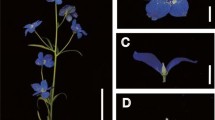Abstract
Brassica oleracea L. vars.italica (broccoli) andbotrytis (cauliflower) both undergo developmental arrests which result in heading phenotypes. We characterized these arrested tissues at the morphological and molecular levels, and defined the developmental changes that ensue after arrest has been broken. We found that the order of floral organ initiation and the positions of resulting floral organ primordia in this species differed in some respects from that ofArabidopsis, which is a member of the same family, Brassicaceae. We also cloned homologs of theArabidopsis floral homeotic genesAPETALA1 (AP1) andAPETALA3 (AP3) fromB. oleracea and characterized their expression patterns. We found that theAP1 homolog was expressed in some of the meristems of arrest-stage cauliflower, providing evidence that this tissue is florally determined. In broccoli, both the API andAP3 homologs were expressed. However, the spatial pattern of expression of the broccoliAP1 homolog differed from that ofArabidopsis. In addition, we identified a homolog of theCAULIFLOWER (CAL) gene,BoiCAL, from broccoli. The predicted amino acid sequence indicated that theBoiCAL gene product does not contain the mutation thought to be responsible for the early arrest exhibited in cauliflower (Kempin et al. 1995), but contains other changes that might play a role in the broccoli heading phenotype.
Similar content being viewed by others
References
Alam Z (1936) Cytological studies of some Indian oleiferous Cruciferae, III. Ann Bot 50: 85–102
Anthony RG, James PE, Jordan BR (1995) The cDNA sequence of a cauliflowerapetala-Ilsquamosa homolog. Plant Physiol 108: 441–442
Anthony RG, James PE, Jordan BR (1996) Cauliflower (Brassica oleracea var. botrytis L.) curd development: the expression of meristem identity genes. J Exp Bot 47: 181–188
Bailey LH (1922) The cultivated Brassicas. I. Gentes Herbarum 1: 53–108
Bowman JL, Alvarez J, Weigel D, Meyerowitz EM, Smyth DR (1993) Control of flower development inArabidopsis thaliana byAPETALA1 and interacting genes. Development 119: 721–743
Coen ES, Romero JM, Doyle S, Elliott R, Murphy G, Carpenter R (1990)floricaula: a homeotic gene required for flower development inAntirrhinum majus. Cell 63: 1311–1322
Crisp P (1982) The use of an evolutionary scheme for cauliflowers in the screening of genetic resources. Euphytica 31: 725–734
Dark SOS (1938) The development of the flowers from the curd of broccoli (Brassica oleracea botrytis). Ann of Bot 2: 751–752
Gray AR, Crisp P (1979) Autumn cauliflower. Rep Natn Veg Res Stn for 1978, 57–58
Irish VF, Sussex IM (1990) Function of theapetala-1 gene duringArabidopsis floral development. Plant Cell 2: 741–753
Irish VF, Yamamoto YT (1995) Conservation of floral homeotic gene function betweenArabidopsis andAntirrhinum. Plant Cell 7: 1635–1644
Jackson D (1991) In situ hybridisation in plants. In Gurr SJ, McPherson MJ, Bowles DJ (eds) Molecular plant pathology, a practical approach. Oxford University Press, Oxford
Jack T, Brockman LL, Meyerowitz EM (1992) The homeotic geneAPETALA3 ofArabidopsis thaliana encodes a MADS box and is expressed in petal and stamens. Cell 68: 683–697
Kempin SA, Savidge B, Yanofsky MF (1995) Molecular basis of thecauliflower phenotype inArabidopsis. Science 267: 522–525
Mandel MA, Gustafson-Brown C, Savidge B, Yanofsky MF (1992) Molecular characterization of theArabidopsis floral homeotic geneAPETALA1. Nature 360: 273–277
Medford JI, Elmer JS, Klee HJ (1991) Molecular cloning and characterization of genes expressed in shoot apical meristems. Plant Cell 3: 359–370
Pease MS (1926) Genetic studies inBrassica oleracea. J Gen 16: 363–385
Prakash H, Hinata K (1980) Taxonomy, cytogenetics and origin of crop Brassicas, a review. Opera Bot 55: 1–57
Sadik S (1962) Morphology of the curd of cauliflower. Am J Bot 49: 290–297
Sadik S, Ozbun JL (1967) Histochemical changes in the shoot tip of cauliflower during floral induction. Can J Bot 45: 952–959
Sambrook J, Fritsch EF, Maniatis T (1989) Molecular cloning, a laboratory manual, 2nd edn. Cold Spring Harbor Laboratory Press, Cold Spring Harbor, NY
Smyth DR, Bowman JL, Meyerowitz, EM (1990) Early flower development inArabidopsis. Plant Cell 2: 755–767
Yarnell SH (1956) Cytogenetics of the vegetable crops. II. Crucifers. Bot Rev 22: 81–166
Yeager AF (1943) The characteristics of crosses between botanical varieties of cabbage,Brassica oleracea. Proc Am See Hort Sci 43: 199–200
Author information
Authors and Affiliations
Corresponding author
Additional information
The GenBank accession numbers for the sequences reported here are: U67451 (Boi2AP1); U67452 (Boi2AP1); U67453 (Boi1AP3); U67455 (Boi2AP3); U67456 (BobAP3); and U67454 (BoiCAL)
Rights and permissions
About this article
Cite this article
Carr, S.M., Irish, V.F. Floral homeotic gene expression defines developmental arrest stages inBrassica oleracea L. vars.botrytis anditalica . Planta 201, 179–188 (1997). https://doi.org/10.1007/BF01007702
Received:
Accepted:
Issue Date:
DOI: https://doi.org/10.1007/BF01007702




